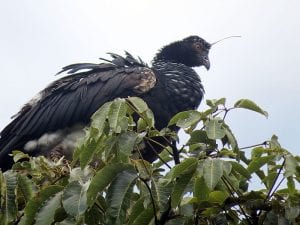Specimen of the Week 305: The Horned Screamer
By Nadine Gabriel, on 25 August 2017
Hello everyone, it’s Nadine Gabriel. I’ve been a familiar face at the Grant Museum over the years and I have recently started an internship here – I’m really looking forward to another year at the museum! Over the past few months, I’ve been accessioning objects in the display cabinets high up in the museum and I have come across many interesting specimens. However, one mounted skeleton with a striking pose really stood out to me and it’s also the only specimen of its species in the Grant Museum. Let’s make some noise for the horned screamer!
A relative of the duck
The horned screamer (Anhima cornuta) belongs to a family of screamers called Anhimidae which also contains the northern and southern screamers. Horned screamers are closely related to ducks, geese and swans since they all belong to the order Anseriformes. But you won’t find horned screamers at your local duck pond. Their range covers a large area in South America and they are commonly found along river banks, fresh water lagoons and tropical wet savannahs.

Distribution of Anhima cornuta across South America. Image by Nrg800 via Wikimedia Commons, CC BY-SA 3.0
Interesting features
With a wingspan of 170 cm and a weight of 3-3.15 kg, horned screamers are big birds. They won’t win any contests for the most colourful bird because they are mostly black with some grey highlights and a white underbelly. Their most striking feature is a 15 cm long “horn” which is made from cartilage and is loosely attached to the skull. They also have two spurs on each wing which are formed from fused carpal bones covered in keratin. These spurs can be up to 6 cm long and can cause a lot of damage. Some individuals have been found with spurs embedded in their body from fights – ouch! You can view a helpful diagram with a summary of their features here.

Putting the horn in horned screamer. Image by Dick Culbert via Wikimedia Commons, CC BY 2.0

Making a point: an illustration of Anhima cornuta showing its wing spurs. Image in the Public Domain
Noisy birds
These birds aren’t called horned screamers for nothing; they are noisy birds and their calls can be heard up to 3 km away. Horned screamers have three call types which are often repeated for hours on end:
- Moo co call is used as an alarm and a relocation call
- Honking call resembles the call of a goose and is used during greeting
- Trumpet call is a long distance call which can carry for up to 3 km. It’s used as the morning wake up call
A unique sound involves the use of air sacs located below the skin. When horned screamers take off, these air sacs rapidly collapse and make a crackling or drumming sound. During pair bonding, the mates produce repeated sounds by using the air sacs in their neck.
Under threat?
Due to their large range, the horned screamer is classed as “Least Concern” by the IUCN. They have faced major threats in the past: they became extinct in Guyana, Trinidad and Suriname in 1909, 1964 and 1966 respectively. Despite an increase in their range in recent years, they are still vulnerable to human activity. Habitat destruction reduces their breeding range and some people hunt them for food. In some communities, they are used to guard chickens from birds of prey.
A symbolic bird
The horned screamer is the official bird of the Department of Arauca and the Municipality of Arauca in Colombia; the Spanish name for horned screamer is Arauco. It’s also a symbol in the National Reserve of Churute in Ecuador and it features on the flag of Tietê, Brazil.
Nadine Gabriel is the Museum Intern at the Grant Museum of Zoology
References
http://animaldiversity.org/accounts/Anhima_cornuta/
https://neotropical.birds.cornell.edu/Species-Account/nb/species/horscr1/overview
http://www.oiseaux-birds.com/card-horned-screamer.html
http://what-when-how.com/birds/screamers-birds/
 Close
Close



